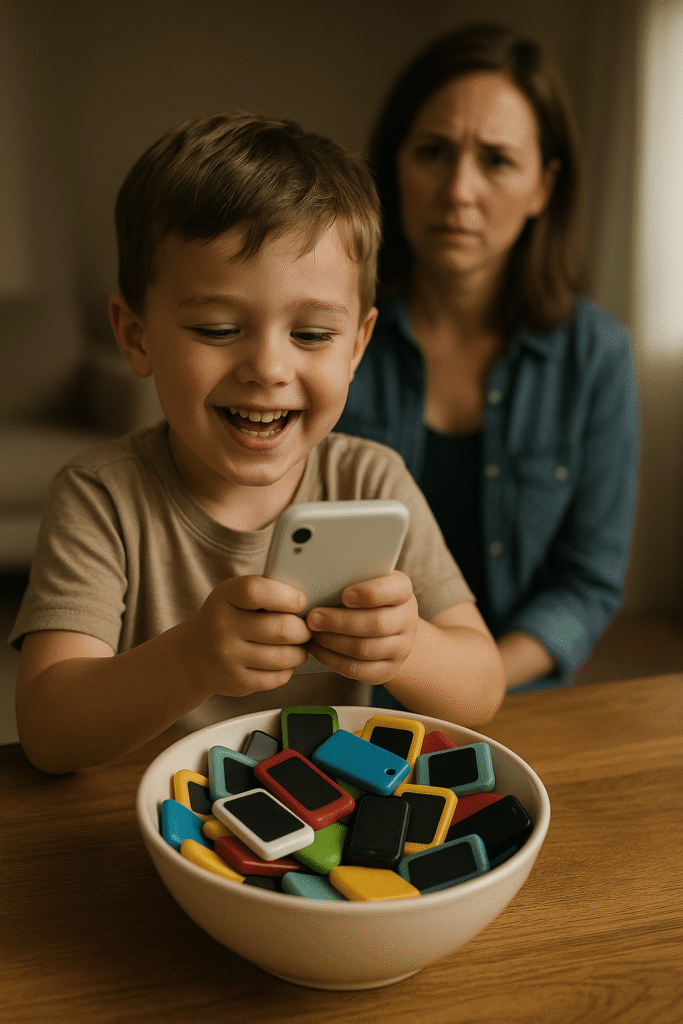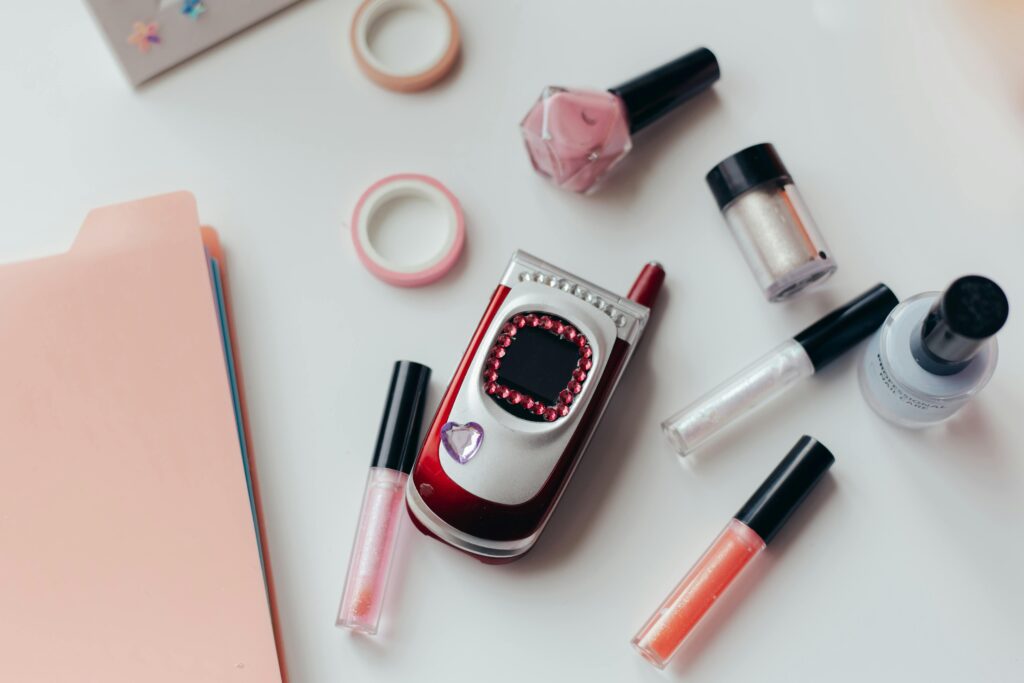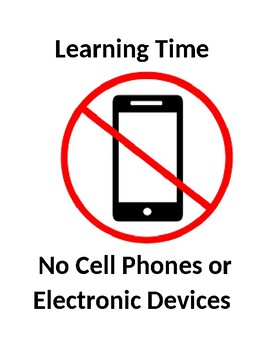
The Trap We Didn’t See Coming (Again)
Picture this: It’s 1965. A loving mother serves her children Sugar Frosted Flakes for breakfast. She believes she’s giving them energy and nutrition. The cartoon tiger on the box promises fun and vitality. She’s making what she thinks is a good choice.
Now picture this: It’s 2025. A mother breastfeeds her baby while scrolling through her phone. She’s staying connected and checking messages. She loves her child deeply. She doesn’t think twice about the glowing screen inches from her baby’s eyes.
A Mother and Society’s Dilemma
Both mothers are doing what feels normal. Both are unknowingly part of a massive experiment on their children’s developing brains. Both represent generations that will eventually ask: “What were we thinking?”
The similarities between sugar and digital technology are striking. It’s as if we didn’t learn from what happened with sugar. This time we’re not just affecting our children’s bodies. We’re affecting their minds.
The Sweet Deception: How We Got Here Before

When Sugar Became “Normal”
For most of human history, sugar was rare. Our ancestors might taste honey sometimes, and fruit in season. But concentrated sweetness was precious and scarce. Then came the Industrial Revolution. Everything changed.
By the 1950s, food companies discovered they could make anything appealing by adding sugar. Breakfast cereals became candy in disguise. “Part of a nutritious breakfast,” they promised. Meanwhile, they loaded children’s bowls with sugar amounts that would have shocked previous generations.
Here’s the truly sneaky part: When health concerns about sugar emerged, companies didn’t reduce it. They learned to hide it. They began using dozens of different names for sugar on labels. High fructose corn syrup, dextrose, maltose, sucrose, barley malt, brown rice syrup, coconut sugar, fruit juice concentrate. The list goes on.
Today, a single product can contain four or five different types of sugar. Each one is listed separately. This makes it nearly impossible for shoppers to know how much sugar they’re actually buying.
The Marketing Assault

The marketing was brilliant and sneaky. Cartoon characters spoke directly to children. This bypassed parents entirely. Mothers were convinced that sugary cereals would give their kids energy and happiness. Companies spent millions studying how to trigger feel-good brain chemicals. They created products that were designed to be impossible to resist.
Sugar Everywhere
Schools became part of the problem without knowing it. They filled vending machines with sugary drinks and snacks. They used candy sales as fundraisers. Birthday parties became sugar festivals. In many families, rewards meant candy. Love meant treats. We created an entire culture where sugar meant happiness, celebration, and care.
The Big Lie
Meanwhile, these same companies were secretly funding research to hide sugar’s health risks. They shifted the blame to fats and other nutrients. Internal documents later showed that some companies knew about sugar’s addictive properties and health problems for decades. Yet they continued aggressive marketing campaigns targeting children.
Sugar Becomes Unavoidable
The result? Today, sugar is everywhere. Walk down any grocery aisle and try to find products without added sugar. Salad dressings, spaghetti sauce, barbecue sauce, bread, crackers, yogurt, soup, and peanut butter. Even products we think are “healthy” contain hidden sugars.
A typical grocery store has over 600,000 food products. An estimated 80% contain added sugar in some form. Shopping for groceries now requires detective skills. You need to read labels and know all the names of sugars.
We created a food world where finding something WITHOUT sugar became the exception, not the rule. Parents trying to feed their families whole foods now have to become expert label readers. They must stay constantly alert for an ingredient that hides in the most unexpected places.
The Habit Normalized
We normalized giving children a substance that hijacked their brain chemistry. It created addiction-like cravings and set them up for lifelong health struggles. And we did it with the best intentions. We trusted that the smiling faces on cereal boxes had our children’s best interests at heart.
The Hidden Became Normal

We normalized giving children a substance that hijacked their brain chemistry. It created addiction-like cravings and set them up for lifelong health struggles. And we did it with the best intentions. We trusted that the smiling faces on cereal boxes had our children’s best interests at heart.
The Hidden Costs Surface
It took decades for the consequences to become undeniable. Obesity rates that had been stable for generations suddenly shot up. Type 2 diabetes, once called “adult-onset” diabetes, began appearing in children. Tooth decay became an epidemic. Heart disease, metabolic syndrome, and many other conditions followed.
The Psychological Damage
But the physical costs were only part of the story. Sugar addiction created psychological patterns that lasted a lifetime. People couldn’t regulate emotions without sweet comfort. They experienced energy crashes that felt like personal failures. They developed complicated relationships with food that willpower couldn’t fix.
Corporate Profits and the Consequences
Meanwhile, corporations made fortunes while individuals and families paid a heavy price. They paid with their health and their hard-earned money. They paid with long-term consequences with their bodies, including being overweight or even getting diabetes.
By the time we understood what had happened, the damage was done. Entire societies, especially in developed countries, had, in essence been rewired around constant sugar consumption. Breaking free required will more than just willpower. It will meant fighting against a food system designed to keep people coming back for more.
The Digital Invasion: Same Script, Different Stage

From Tool to Obsession
Cell phones started as simple communication tools. Really simple. When Martin Cooper made the first public mobile call in 1973, he held a massive 2.5-pound “brick.” It could barely fit in a briefcase. For decades, these devices did one thing: make phone calls. They were expensive, clunky, and used by very few people.
Even into the 1990s, cell phones remained basic communication devices. The device fundamentally served the user’s needs, instead of trying to capture their attention.
But just as food companies discovered they could make anything appealing with sugar, tech companies discovered they could make any device compelling with psychological tricks. The turning point wasn’t gradual. It was swift and deliberate.
The smartphone, introduced by Apple in 2007, changed everything. This wasn’t just an improvement. It was a complete shift. Suddenly, we carried mini-computers in our pockets. Teams of brain scientists and behavioral psychologists designed them. Their goal was to deliver rewards at random times, create fear of missing out, and make us reach for them hundreds of times per day.
Think about that timeline: From 1973 to 2007 (34 years), cell phones remained simple communication tools. Then, in less than two decades since the iPhone launch, these devices completely changed human behavior and social interaction.
The Ultimate Red Flag: When Creators Won’t Use Their Products

Perhaps the most telling sign that something was wrong came from an unexpected source: the very people creating these devices.
Tech Leaders Protect Their Own Kids
Steve Jobs, who introduced the iPhone, famously limited his own children’s screen time. In a 2014 interview, when asked if his kids used the newly released iPad, he said: “They haven’t used it. We limit how much technology our kids use at home.”
Jobs wasn’t alone. Microsoft founder Bill Gates strictly limited his children’s technology exposure. He banned them from owning cell phones until age 14. He restricted screen time to 45 minutes for games plus one hour on weekends.
Apple CEO Tim Cook has been equally restrictive about his nephew’s technology use. He stated: “I don’t want them on a social network.””
The Confession
Perhaps most damning was Facebook’s founding president Sean Parker. In 2017, he admitted that the platform was deliberately designed to be addictive. “The thought process that went into building these applications was all about: ‘How do we consume as much of your time and conscious attention as possible?’” Parker warned: “God only knows what it’s doing to our children’s brains.”
How Phones Were Made to Be Irresistible

Think about that: The people who designed these products to be irresistible deliberately kept them away from their children. They knew something the rest of us were only beginning to suspect.
This wasn’t casual parenting. It was an informed choice based on inside knowledge. These executives understood the addictive design because they had created it. They knew the psychological tricks because they had built them in. And they chose to protect their children from what they were selling to everyone else.
Meanwhile, they continued marketing these same devices to families worldwide as educational tools. They called them essential technology for children’s development. The hypocrisy is staggering and should have been our biggest warning sign.
Apps weren’t designed to serve us. They were designed to capture and sell our attention. The endless scroll, the notification ping, the red badge of urgency—all carefully crafted to create digital addiction.
For More information, check out this Article “Ways Your Smartphone Can Wreck Your Health which you can find HERE
Sugar & Cell Phones Parallel Gets Stronger

Here’s where the comparison to sugar becomes even more striking: Just as sugar companies gradually made their product essential by hiding it in everything, tech companies have made smartphones essential by embedding them into every aspect of daily life.
Everything Requires a Phone
Want to pay your bills? You need the app. Want to ride the bus? You need your phone to pay. Banking, shopping, work communication, social connection, navigation, entertainment—everything now flows through this single device. Even our children’s education increasingly requires screen time.
The Illusion of Choice
We’ve created a system where “opting out” isn’t an option anymore. Try going without your smartphone for a week in 2025. You’ll quickly discover how many basic life functions now require this device. Just like sugar, what started as an optional enhancement has become mandatory for survival in modern society.
The brilliant trick is that we believe we chose this. We think we’re in control, making individual decisions about our phone use. In reality, we’re responding to sophisticated manipulation techniques that make the sugar industry’s marketing look primitive.
And just like with sugar, we handed these devices to our children and called it progress.
Parents Lost in the Glow

Walk through any playground, restaurant, or family gathering today and the scene is unmistakable: parents are physically present but mentally elsewhere, absorbed in their screens while their children compete for attention.
Missing the Most Important Moments
The most intimate moments of child-rearing have been invaded. Parents scroll while pushing strollers. They check messages during bedtime stories. They drop phones on babies’ heads while breastfeeding—not once but many times. Then they share these incidents online as if they’re just normal parenting mishaps rather than red flags of dependency.
These aren’t just missed moments. Children learn their worth through their parents’ eyes. Increasingly, those eyes are looking elsewhere. What’s scary is that some children are now bonding with their technology instead of their parents.
The Digital Babysitter
Screens have become the go-to solution for every parenting challenge. Bored child? Here’s a tablet. Tantrum in the grocery store? Hand over the phone. Long car ride? Everyone gets their device.

The False Promise of Education
We’ve convinced ourselves this is educational, even beneficial. “Educational apps” and “learning games” provide the same cover that “part of a nutritious breakfast” once did. We’re not giving our children digital candy. We’re giving them tools for success.
What We’re Really Doing
What is happening far too often is that too many parents are, in essence, outsourcing some of the most important aspects of child development: learning to tolerate boredom, regulate emotions, engage with the physical world, and connect with other human beings.
Many parents don’t understand that a young child’s brain is wide open. It’s absorbing everything around it. A child can, in an instant, also make a life-changing decision, such as “no one loves me,” which can stay with them for life. This can happen as a result of their inability to get a parent’s conscious attention.
Sadly, too many parents don’t understand the importance of their conscious attention in developing a healthy child who will become a healthy adult. Many parents don’t fully realize the messages they’re sending unconsciously to their children by not being present.
The Parallel Unveiled
The Wisdom of Experience

Before we look at how corporations used identical tactics with sugar and screens, it’s worth noting something interesting: Older generations who lived through the sugar epidemic are notably less interested in smartphones than younger people.
This isn’t simply about being “set in their ways” or “not understanding technology.” Having spent decades battling sugar cravings, weight struggles, and health issues that stemmed from childhood exposure to addictive substances, many older adults seem to possess an unconscious wariness. They seem to be suspicious of anything that promises instant gratification and constant stimulation.
When you’ve spent your adult life trying to undo patterns formed in childhood by corporate manipulation, you’re naturally more cautious about the next “revolutionary” product that promises to make life better while demanding constant engagement.
This generational difference represents hard-earned wisdom. The tragedy is that the people with the wisdom to recognize these patterns—parents and grandparents who lived through the sugar epidemic—are too often dismissed as being behind the times. Meanwhile, the generation that never learned to question addictive design is now raising children in an environment of unprecedented digital stimulation.
The Apparent Corporate Playbook

The similarities between how sugar and digital technology infiltrated our lives aren’t coincidental; research reveals they appear to follow the same corporate strategies:
Target the Vulnerable:
Studies show that 67% of apps used by preschool-aged children collect and share personally identifying information with third-party marketing companies, and 87.5% of apps delisted by Apple and Google for problematic practices specifically targeted children aged 12 and under. Research indicates that “design features created to serve the interests of technology companies over children is common”.
Exploit Parental Love:
Both industries convinced parents that their products were beneficial for children. Sugar gave kids energy and made them happy. Screens provide education and keep them safe. Love your children? Give them what they want.
Create Physical Dependency:
Facebook’s founding president Sean Parker admitted the platform was designed to “exploit a vulnerability in human psychology” and create “a social-validation feedback loop” that delivers dopamine hits. Both sugar and screens hijack dopamine pathways, creating genuine physiological responses that make stopping extremely difficult.
Normalize the Abnormal:
Through marketing, peer pressure, and institutional adoption, both industries made their products seem not just normal but necessary. Studies show that 5.5% of apps in children’s sections of app stores claim not to be targeted toward children, despite being featured in child-specific sections and sometimes featuring the word “kids” in their names.
Privatize Profits, Socialize Costs:
Legal documents reveal that Meta allegedly “harmed young users on Facebook and Instagram through the use of highly manipulative algorithms and technological tools” while collecting personal information for advertisers. Corporations make billions while families, healthcare systems, and society bear the costs of addiction, health problems, and developmental damage.
The Denial Phase

Most of humanity appears to be clearly in the denial phase with digital technology, just as we once were with sugar. The same phrases appear:
“Everything in moderation” (while using devices that are specifically designed to make moderation impossible)
“You can’t avoid it completely in modern society” (ignoring that complete avoidance isn’t necessary—conscious, limited use is)
“The benefits outweigh the risks” (often without actually understanding what the risks are)
“My children are fine” (while they struggle with attention, sleep, anxiety, and social skills in unprecedented ways)
For More ways to Help Humanity, check my article: The Self-Image Crisis: Why Humanity’s Survival Depends on Transformation, which you can find HERE
What We’re Losing
The Simple Joys of Being Present
Walk through any neighborhood, restaurant, or family gathering and notice what’s missing: children playing outdoors, exploring their environment with curiosity, friends deeply engaged in conversation, families sitting at dinner tables talking to each other. Instead, we see heads down, eyes glued to screens, even in the most beautiful outdoor settings.
Children are losing the ability to simply be present in the world around them. They’re missing the magic of discovering an interesting bug, the satisfaction of climbing a tree, and the social skills developed through unstructured play with friends. Public spaces that once buzzed with conversation now hum with the silence of people absorbed in their digital worlds.
We’re raising a generation that doesn’t know how to sit with themselves, observe their surroundings, or engage spontaneously with the people and environment around them. The art of people-watching, noticing seasonal changes, or simply enjoying a meal without distraction, is becoming extinct

Present-Moment Awareness
Perhaps the most profound loss is our capacity for presence, the ability to be fully here, now, with the people and experiences in front of us. Constant connectivity fragments attention and makes deep engagement nearly impossible.
Children are growing up without ever seeing adults fully present. They’re learning that boredom must be immediately escaped, that solitude is uncomfortable, and that constant stimulation is normal.
Human Connection and Emotional Attunement
The quality of parent-child interaction has fundamentally changed. Eye contact, emotional responsiveness, and the subtle dance of attunement that builds secure attachment, all of this is disrupted when one party is partially absorbed in a device.
Children learn to read emotions, develop empathy, and regulate their own feelings through close observation of their caregivers’ faces and responses. Screens interfere with this ancient, essential process.
Natural Development Rhythms
Children’s brains develop in stages, each building on the previous one. Early years are meant for sensory exploration, physical movement, and social interaction. Flooding developing minds with artificial stimulation can disrupt these natural progressions in ways we’re only beginning to understand.
The Reckoning That’s Coming
Future Studies, Future Regrets
The long-term studies are already beginning. Researchers are tracking children who grew up with screens from infancy, and the early results are concerning: higher rates of anxiety and depression, attention difficulties, sleep problems, and social skill deficits.
We’re conducting a massive, uncontrolled experiment on human development, and the early data suggests we won’t like the results.
In twenty years, we may look back at today’s screen-saturated childhood the way we now look back at feeding children sugar for breakfast—with horror and regret.
The Questions We’ll Ask
Future parents will ask the same questions we now ask about sugar:
“How did we not see this coming?” “Why didn’t anyone warn us?” “How could we have been so blind?”
But some of us are asking these questions now. Some of us can see the pattern repeating and choose a different path.
Breaking the Cycle: A Call to Consciousness

Recognition Without Shame
Understanding that we’ve been manipulated isn’t about guilt; it’s about empowerment. Both sugar and tech companies employed sophisticated psychological techniques to override our instincts and judgment. Recognizing this manipulation is the first step toward freedom.
Parents who are struggling with their device use or their children’s screen time aren’t weak or bad; they’re responding predictably to systems designed to create compulsive use.
Practical Steps for Awareness
Start with yourself: Notice your device use. How often do you check your phone? How does it feel to leave it in another room? Your children are always watching and learning.
Create sacred spaces: Designate phone-free zones and times, meals, bedrooms, the first hour after waking up, and the last hour before bed.
Choose presence over productivity: The urge to multitask while with children is strong, but presence is more valuable than any email or social media update.
Teach emotional regulation: Instead of handing a child a screen when they’re upset, help them learn to tolerate and work through difficult feelings.
Model the behavior you want to see: Children learn more from what they observe than what they’re told. Be the present, engaged adult you want them to become.
Questions for Reflection
- Am I fully present with my child, or am I partially elsewhere?
- What behaviors am I modeling about attention, presence, and human connection?
- Is this screen helping my child develop important skills, or is it replacing experiences they need?
- How would my childhood have been different if my parents had been constantly distracted by devices?
The Choice Is Still Ours
We couldn’t prevent the sugar epidemic, and we didn’t recognize it until the damage was widespread. But we can still influence the trajectory of the digital age.

Our children’s neurological development, their capacity for attention and connection, their fundamental sense of worth and belonging—all of this is being shaped right now by the choices we make about presence and distraction.
It’s about all of us, it is about recognizing how we can so easily adopt something that works against us, how susceptible we can be, how can we buy into corporate greed, and in the process lose ourselves.
The window for conscious choice is still open, but it’s narrowing. Every day that passes, more children are having their earliest experiences of love and safety filtered through the divided attention of screen-absorbed parents.
We have the opportunity to be the generation that says “enough.” The generation that chooses connection over convenience, presence over productivity, and human attention over artificial stimulation.
With our children, especially, progress isn’t giving a child a screen; it’s giving them something far more precious and increasingly rare: an adult’s full, undivided attention.
The question isn’t whether we can completely avoid screens in modern life. The question is whether we can use them consciously and intentionally, without letting them use us.
Our children’s future and our humanity may depend on how we answer.
For Further Reading about: “Are Cell Phones the New Sugar?”
Tech Executives Limiting Children’s Screen Time:
- Bilton, Nick. “Steve Jobs Was a Low-Tech Parent.” The New York Times, September 10, 2014.
- “Tech-free dinners and no smartphones past 10 pm — how Steve Jobs, Bill Gates and Mark Cuban limited their kids’ screen time.” CNBC, June 5, 2018.
- Stillman, Jessica. “Why Steve Jobs and Bill Gates Both Severely Limited Their Kids’ Tech Use.” Inc.com, February 6, 2020.
Sean Parker Facebook Admissions:
- Allen, Mike. “Sean Parker unloads on Facebook: ‘God only knows what it’s doing to our children’s brains.’” Axios, November 9, 2017.
- “Sean Parker Says Facebook Was Designed to Be Addictive.” Ad Age, November 9, 2017.
Children’s App Data Collection:
- Radesky, Jenny, et al. “Data Collection Practices of Mobile Applications Played by Preschool-Aged Children.” JAMA Pediatrics, September 2020.
- Fowler, Geoffrey. “How tech companies and apps are tracking kids’ data.” NPR, June 16, 2022.
Sugar Industry Research:
- Kearns, Cristin E., Laura A. Schmidt, and Stanton A. Glantz. “Sugar Industry and Coronary Heart Disease Research.” JAMA Internal Medicine, 2016.
- O’Connor, Anahad. “How the Sugar Industry Shifted Blame to Fat.” The New York Times, September 12, 2016.
Children and Media Violence:
- McCarthy, Claire. “Protecting children from the dangers of virtual violence.” Harvard Health Publishing, Harvard Medical School.
App Design and Children:
- Radesky, Jenny, et al. “Prevalence and Characteristics of Manipulative Design in Mobile Applications Used by Children.” JAMA Network Open, 2022.
- “Design tricks commonly used to monetize young children’s app use.” University of Michigan Health Lab, 2022.
Mobile Phone History:
- “The History of Mobile Phones From 1973 To 2008: The Handsets That Made It ALL Happen.” Know Your Mobile, 2021.

Leave a Reply
You must be logged in to post a comment.